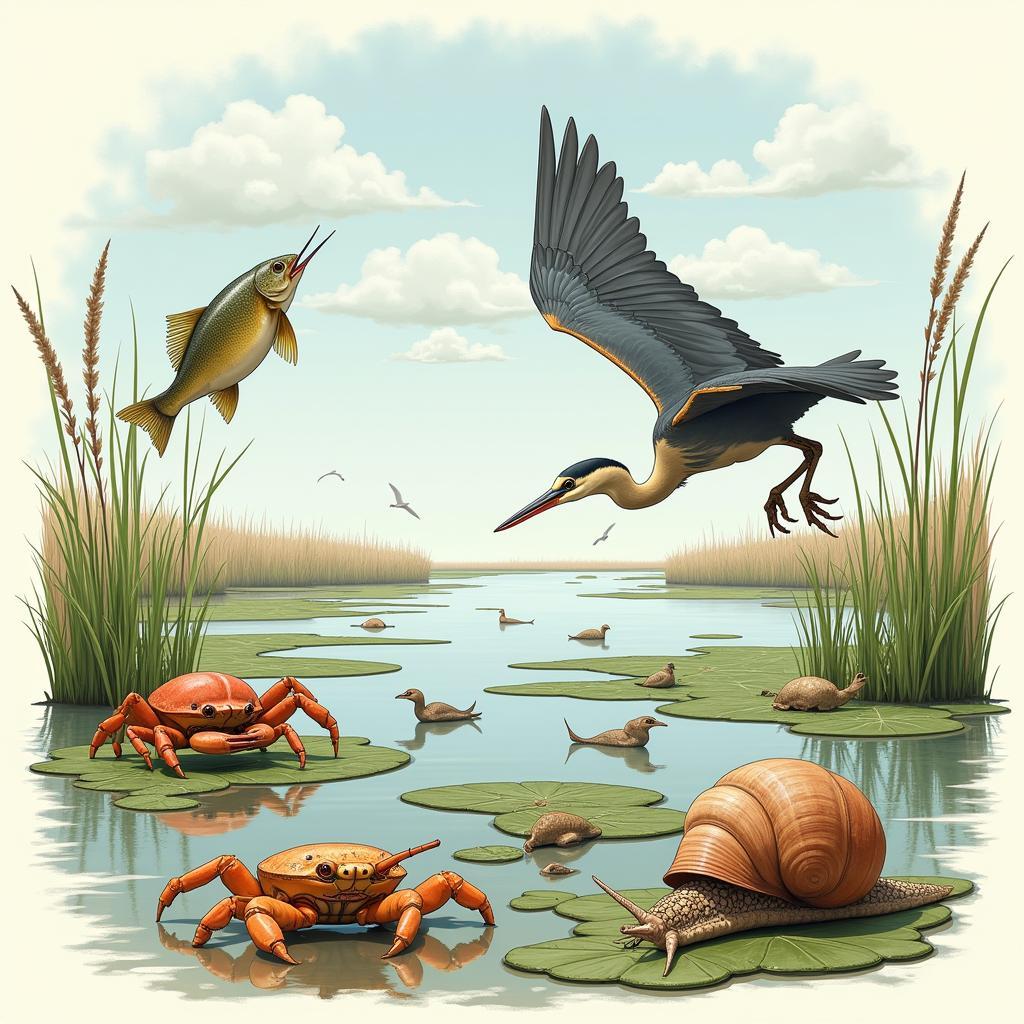The Saltwater Marsh Food Web is a complex and fascinating network of life, a delicate dance between predator and prey. From microscopic algae to majestic herons, every organism plays a vital role in maintaining the health and balance of this unique ecosystem. Understanding this intricate web is crucial to appreciating the importance of saltwater marshes and conserving these valuable habitats.
The Foundation: Producers in the Saltwater Marsh
The base of the saltwater marsh food web lies with the producers, the organisms that convert sunlight into energy through photosynthesis. These include various types of algae, phytoplankton, and marsh grasses like Spartina alterniflora. These plants are incredibly productive, forming the foundation upon which the entire ecosystem thrives. They provide food and shelter for a wide array of creatures, from tiny invertebrates to large mammals.
Consumers: The Hungry Inhabitants of the Marsh
The next level of the saltwater marsh food web consists of the consumers, the organisms that feed on the producers or other consumers. This diverse group includes:
- Herbivores: Animals like snails, crabs, and certain fish species graze on the algae and marsh grasses, converting plant matter into animal tissue. Muskrats and some bird species also consume large quantities of plant material.
- Carnivores: Predatory fish, such as killifish and blue crabs, feed on smaller invertebrates and fish. Larger predators like diamondback terrapins and herons consume crabs, fish, and other smaller animals. At the top of the food web are apex predators like ospreys and bald eagles, which hunt fish and other birds.
- Omnivores: Some animals, like raccoons and certain fish species, are omnivores, consuming both plant and animal matter. This adaptability allows them to exploit a wider range of food sources within the marsh.
 Various Consumers in the Saltwater Marsh
Various Consumers in the Saltwater Marsh
Decomposers: The Recycling Crew
No food web is complete without the decomposers. Bacteria and fungi break down dead plant and animal matter, returning essential nutrients back to the ecosystem. This process is crucial for maintaining the health and productivity of the marsh. These nutrients are then available for the producers to utilize, completing the cycle.
What animals eat Spartina in the salt marsh?
Spartina, a dominant plant in saltwater marshes, is a vital food source for several animals. Directly, it’s grazed upon by snails, crabs, and some insects. However, its primary role is as a source of detritus, the dead and decaying plant matter that forms the base of the food web for many invertebrates and fish.
How does human activity impact the saltwater marsh food web?
Human activities, such as pollution and habitat destruction, can have devastating impacts on the delicate balance of the saltwater marsh food web. Pollution can introduce toxins that accumulate in the food chain, harming or killing organisms at all levels. Habitat loss reduces the available resources for plants and animals, disrupting the intricate web of life.
“The interconnectedness of the saltwater marsh food web is remarkable,” says Dr. Emily Carter, a marine ecologist specializing in coastal ecosystems. “Even seemingly small changes can have cascading effects throughout the entire system.”
 Human Impact on Saltwater Marsh
Human Impact on Saltwater Marsh
Dr. Carter further emphasizes, “Protecting these fragile ecosystems is crucial, not only for the diverse array of life they support but also for the vital services they provide, such as protecting coastlines from erosion and filtering pollutants.”
In conclusion, the saltwater marsh food web is a complex and dynamic system. From the smallest algae to the largest predators, every organism plays a vital role. Understanding and protecting these intricate webs is essential for ensuring the health and sustainability of our coastal ecosystems.
FAQ
- What is the primary producer in a saltwater marsh? Algae and marsh grasses like Spartina.
- What are some examples of consumers in a saltwater marsh? Snails, crabs, fish, herons, and eagles.
- What is the role of decomposers in the food web? They break down dead organic matter and recycle nutrients.
- How does pollution affect the saltwater marsh food web? Toxins can accumulate in the food chain, harming organisms.
- Why are saltwater marshes important? They provide habitat, protect coastlines, and filter pollutants.
- What is an apex predator in a saltwater marsh? Ospreys and bald eagles.
- How does Spartina contribute to the food web? It serves as a food source and provides detritus.
For further assistance, please contact us at Phone Number: 02437655121, Email: minacones@gmail.com Or visit us at: 3PGH+8R9, ĐT70A, thôn Trung, Bắc Từ Liêm, Hà Nội, Việt Nam. We have a 24/7 customer service team.